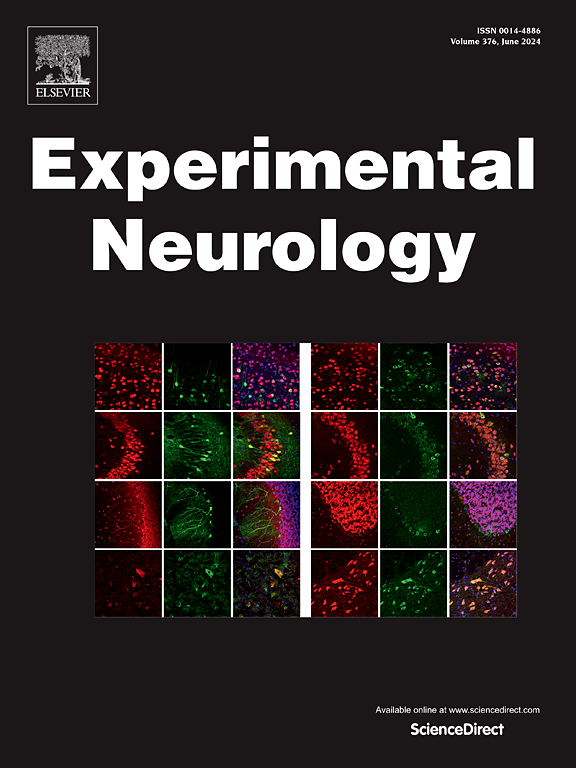Hspa8突触伴侣的变体可改变SOD1G86R肌萎缩性脊髓侧索硬化症小鼠模型的病情。
IF 4.6
2区 医学
Q1 NEUROSCIENCES
引用次数: 0
摘要
肌萎缩性脊髓侧索硬化症(ALS)是一种相对常见的致命性瘫痪性运动神经元疾病,目前几乎没有治疗方法。渐冻人症常常与泛素阳性的运动神经元聚集有关,这种病理现象表明蛋白稳态紊乱。事实上,参与蛋白质运输和降解的细胞伴侣往往是家族性 ALS 的病因。脊髓性肌肉萎缩症(SMA)是由运动神经元缺失和肌肉萎缩导致的第二种常见瘫痪病症。虽然脊髓性肌萎缩症现已得到有效治疗,但该病的运动神经元变性机制仍不清楚。为了解决有关 SMA 的机理问题,我们最近发现了一种该病的遗传修饰因子。该因子是组成型表达的细胞伴侣蛋白 Hspa8 的 G470R 变体,它能阻止运动神经元丢失,防止神经末梢神经丝聚集的异常积累,并抑制疾病的发生。Hspa8 因其在自噬中的作用而广为人知。在它的众多客户中,包括与 ALS 相关的超氧化物歧化酶 1(SOD1)蛋白。鉴于 Hspa8 可抑制 SMA 表型,我们测试了 Hspa8G470R 在突变 SOD1 ALS 小鼠模型中的潜在疾病缓解作用。出乎意料的是,表达 G470R 变体的突变 SOD1 小鼠病情加重。小鼠的运动能力下降,肌肉萎缩加剧,寿命进一步缩短。奇怪的是,小鼠脊髓组织中的 SOD1 蛋白却显著减少。我们的研究结果表明,Hspa8 可调节 ALS 表型。然而,G470R变体非但不会减轻疾病,反而会加重病情。本文章由计算机程序翻译,如有差异,请以英文原文为准。
A variant of the Hspa8 synaptic chaperone modifies disease in a SOD1G86R mouse model of amyotrophic lateral sclerosis
Amyotrophic lateral sclerosis (ALS) is a relatively common and invariably fatal, paralyzing motor neuron disease for which there are few treatment options. ALS is frequently associated with ubiquitin-positive motor neuronal aggregates, a pathology suggestive of perturbed proteostasis. Indeed, cellular chaperones, which are involved in protein trafficking and degradation often underlie familial ALS. Spinal muscular atrophy (SMA) is a second, common paralytic condition resulting from motor neuron loss and muscle atrophy. While SMA is now effectively treated, mechanisms underlying motor neuron degeneration in the disease remain far from clear. To address mechanistic questions about SMA, we recently identified a genetic modifier of the disease. The factor, a G470R variant in the constitutively expressed cellular chaperone, Hspa8, arrested motor neuron loss, prevented the abnormal accumulation of neurofilament aggregates at nerve terminals and suppressed disease. Hspa8 is best known for its role in autophagy. Amongst its many clients is the ALS-associated superoxide dismutase 1 (SOD1) protein. Given its suppression of the SMA phenotype, we tested potential disease-mitigating effects of Hspa8G470R in a mutant SOD1 mouse model of ALS. Unexpectedly, disease in mutant SOD1 mice expressing the G470R variant was aggravated. Motor performance of the mice deteriorated, muscle atrophy worsened, and lifespan shrunk even further. Paradoxically, SOD1 protein in spinal cord tissue of the mice was dramatically reduced. Our results suggest that Hspa8 modulates the ALS phenotype. However, rather than mitigating disease, the G470R variant exacerbates it.
求助全文
通过发布文献求助,成功后即可免费获取论文全文。
去求助
来源期刊

Experimental Neurology
医学-神经科学
CiteScore
10.10
自引率
3.80%
发文量
258
审稿时长
42 days
期刊介绍:
Experimental Neurology, a Journal of Neuroscience Research, publishes original research in neuroscience with a particular emphasis on novel findings in neural development, regeneration, plasticity and transplantation. The journal has focused on research concerning basic mechanisms underlying neurological disorders.
 求助内容:
求助内容: 应助结果提醒方式:
应助结果提醒方式:


